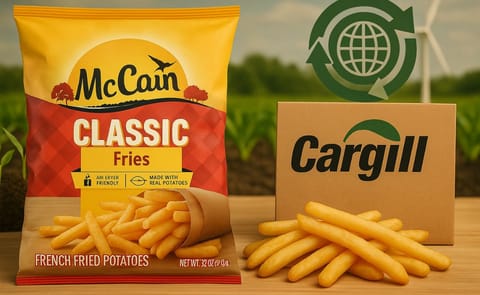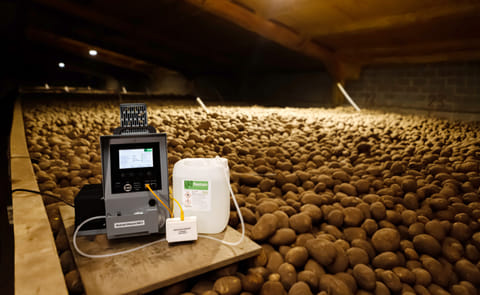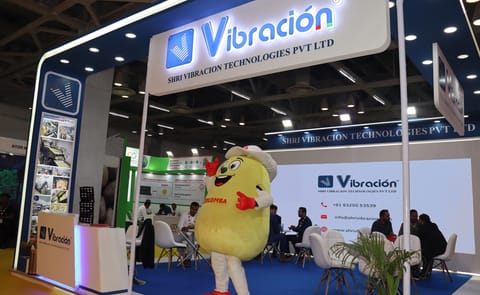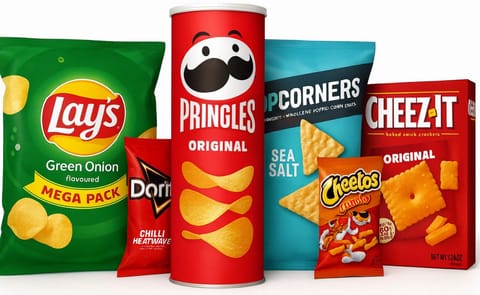Lamb Weston Reports Fiscal First Quarter 2022 Results; Updates Fiscal Year 2022 Outlook
Potato Processor Lamb Weston Reports Fiscal First Quarter 2022 Results.

First Quarter Fiscal 2022 Highlights
- Net sales increased 13% to USD 984 million
- Income from operations declined 56% to USD 60 million
- Net income declined 67% to USD 30 million
- Diluted EPS declined 67% to USD 0.20 from USD 0.61
- Adjusted EBITDA including unconsolidated joint ventures(1) declined 39% to USD 123 million
- Returned USD 60 million of cash to stockholders, including USD 34 million in dividends and USD 26 million in share repurchases
Updated FY 2022 Outlook
- Net sales growth above the long-term target range of low-single digits
- Net income and Adjusted EBITDA including joint ventures(1) to be pressured through fiscal 2022
Lamb Weston Holdings, Inc. (NYSE: LW) announced its fiscal first-quarter 2022 results.
Tom Werner, President, and CEO:
"Our first-quarter sales results reflect the ongoing broad recovery within the frozen potato category, with overall demand in North America near pre-pandemic levels, and our shipments improving in each of our core restaurant and foodservice sales channels."Q1 2022 Commentary
"However, the impact of extreme summer heat that negatively affected potato crops in the Pacific Northwest, combined with industrywide operational challenges, including highly inflationary input and transportation costs, labor availability, and upstream and downstream supply chain disruptions, will result in higher costs as the year progresses, and significantly pressure our earnings."
"Accordingly, we expect our gross profit margins to remain below pre-pandemic levels through fiscal 2022."
"Our experienced team is taking specific actions intended to mitigate these challenges, most notably executing pricing actions to offset commodity inflation, restructuring freight policies, modifying production and crewing schedules to reduce labor volatility, adopting new policies and practices to attract and retain manufacturing employees, and rationalizing our product portfolio."
"We expect our team’s focus on resolving these challenges, as well as our investments in productivity, technology, and capacity to support customer growth, will have us back on track to drive profitable growth and create value for our stakeholders over the long term."
Net sales increased USD 112.7 million to USD 984.2 million, up 13 percent versus the prior-year quarter, with volume up 11 percent and price/mix up 2 percent.
The increase in sales volumes predominantly reflected the recovery in demand for frozen potato products outside the home, which more than offset the decline in retail volume that largely resulted from lower shipments of private label products resulting from incremental losses of the certain low-margin business, and as food-at-home purchases begin to normalize to pre-pandemic levels.
Pricing actions, including the benefit of higher prices charged to customers for product delivery, as well as favorable mix, drove the increase in price/mix in each of the Company’s core business segments.
Income from operations declined USD 75.5 million to USD 60.2 million, down 56 percent versus the prior-year quarter, reflecting lower gross profit and higher selling, general and administrative expenses ("SG& A"). Gross profit declined USD 62.5 million, as the benefit of increased sales volumes was more than offset by higher manufacturing and distribution costs on a per-pound basis.
The higher costs per pound predominantly reflected double-digit cost inflation from key inputs, particularly edible oils, and transportation, particularly trucking and ocean freight. In addition, the Company incurred higher manufacturing costs per pound due to volatile labor availability, which was in part a result of COVID-related absenteeism, that affected production run-rates and throughput.
The decline in gross profit also included a USD 5.6 million decrease in unrealized mark-to-market adjustments associated with commodity hedging contracts, which includes a USD 1.2 million gain in the current quarter, compared with a USD 6.8 million gain related to these items in the prior-year quarter.
An increased USD 13.0 million compared to the prior-year quarter, primarily due to investments to improve the Company’s information technology, commercial, and supply chain operations over the long term, as well as increased compensation and benefits expenses.
These investments included more than USD 4 million of non-recurring expenses (primarily consulting expenses) associated with a new enterprise resource planning system (“ERP”), compared to approximately USD 1 million in the prior-year quarter. In addition, advertising and promotional expenses ("A& P") increased USD 2.9 million, largely in support of the launch of new products in the Retail segment.
Net income was USD 29.8 million, down USD 59.5 million versus the prior-year quarter, and Diluted EPS was USD 0.20, down USD 0.41 versus the prior-year quarter, driven by a decrease in income from operations and equity method investment earnings.
Adjusted EBITDA including unconsolidated joint ventures(1) declined USD 78.4 million to USD 123.4 million, down 39 percent versus the prior-year quarter, driven by lower income from operations and equity method investment earnings.
The Company’s effective tax rate(2) in the first fiscal quarter was 22.6 percent, versus 23.9 percent in the prior-year period. The Company’s effective tax rate varies from the U.S. statutory tax rate of 21 percent principally due to the impact of U.S. state taxes, foreign taxes, permanent differences, and discrete items.
Q1 2022 Segment Highlights
Global
Net sales for the Global segment, which is generally comprised of the top 100 North American based quick service (“QSR”) and full-service restaurant chain customers as well as all of the Company’s international sales, increased USD 53.7 million to USD 501.2 million, up 12 percent versus the prior-year quarter, with volume up 10 percent and price/mix up 2 percent.
The sales volumes increase reflects the recovery in demand in the U.S. and most of the Company’s key international markets, as well as the benefit of limited-time product offerings. The increase in price/mix largely reflected favorable prices, including higher prices charged for freight.
Global segment product contribution margin declined USD 35.2 million to USD 42.6 million, down 45 percent versus the prior-year quarter. Input and transportation cost inflation, as well as higher manufacturing costs per pound, more than offset the benefit of higher sales volumes and favorable price/mix.
Foodservice
Net sales for the Foodservice segment, which services North American foodservice distributors and restaurant chains generally outside the top 100 North American based restaurant chain customers, increased USD 84.7 million to USD 321.4 million, up 36 percent versus the prior-year quarter, with volume up 35 percent and price/mix up 1 percent.
The continued recovery in demand at small and regional chain restaurants, as well as independently-owned restaurants, drove the increase in sales volumes. Shipments to non-commercial customers, such as lodging and hospitality, healthcare, schools and universities, sports and entertainment, and workplace environments, also increased versus the prior-year quarter but remained below pre-pandemic levels.
Volume growth was tempered by the inability to service full customer demand due to lower production run-rates and throughput. The increase in price/mix largely reflected favorable prices, including higher prices charged for freight.
The foodservice segment's product contribution margin increased USD 10.6 million to USD 96.4 million, up 12 percent compared to the prior-year quarter. Higher sales volumes and favorable price/mix drove the increase and were partially offset by input and transportation cost inflation, as well as higher manufacturing costs per pound.
Retail
Net sales for the Retail segment, which includes sales of branded and private label products to grocery, mass merchant, and club customers in North America, declined USD 21.4 million to USD 132.5 million, down 14 percent versus the prior-year quarter, with volume down 15 percent and price/mix up 1 percent.
The sales volume decline largely reflects lower shipments of private label products resulting from incremental losses of the certain low-margin business, and to a lesser extent, a slight decline in branded product sales volumes as food-at-home purchases began to normalize to pre-pandemic levels.
However, total shipments of the Company’s branded products in the current quarter were well above pre-pandemic levels. The increase in price/mix was largely driven by favorable prices, including higher prices charged for freight.
Retail segment product contribution margin declined USD 21.0 million to USD 14.8 million, down 59 percent versus the prior-year quarter. Input and transportation cost inflation, higher manufacturing costs per pound, lower sales volumes, and a USD 2.1 million increase in A&P expenses to support new product launches, drove the decline.
Equity Method Investment Earnings
Equity method investment earnings from unconsolidated joint ventures in Europe, the U.S., and South America were USD 6.2 million and USD 11.9 million for the first quarter of fiscal 2022 and 2021, respectively.
Equity method investment earnings included a USD 4.3 million unrealized gain related to mark-to-market adjustments associated with currency and commodity hedging contracts in the current quarter, compared to a USD 4.7 million unrealized gain related to these items in the prior-year quarter.
Excluding the mark-to-market adjustments, earnings from equity method investments declined USD 5.3 million compared to the prior-year period. The earnings decline largely reflects input cost inflation and higher manufacturing costs in Europe and the U.S.
Cash Flow and Liquidity
Net cash from operating activities was USD 161.8 million, down USD 88.8 million versus the prior year. Capital expenditures, including information technology expenditures, were USD 78.9 million, up USD 45.7 million versus the prior year period reflecting increased investments behind capacity expansion projects.
On August 11, 2021, the Company amended its revolving credit facility to increase its capacity to USD 1.0 billion and to extend the maturity date to August 11, 2026. In connection with the amendment, the Company also amended its agreement with Northwest Farm Credit Services to decrease the pricing applicable to one of its term loans, as well as to modify certain other provisions, including covenants, that correspond to the Company’s revolving credit facility.
At the end of the fiscal first quarter, no borrowings were outstanding under the amended revolving credit facility, and the Company had approximately USD 790 million of cash and cash equivalents.
Capital Returned to Shareholders
In the first quarter, the Company returned a total of USD 60.4 million to shareholders, including USD 34.4 million in cash dividends and USD 26.0 million through share repurchases. The average price per share repurchased during the quarter was USD 65.86. The Company has approximately USD 144 million remaining under its existing USD 250 million share repurchase authorization.
Fiscal 2022 Outlook
The Company continues to expect fiscal 2022 net sales growth will be above its long-term target of low-to-mid single digits. The Company continues to anticipate net sales growth in the second quarter of fiscal 2022 will be driven largely by higher volume, reflecting an ongoing recovery in demand for frozen potato products, as well as a favorable comparison to relatively soft shipments in the second quarter of fiscal 2021.
The Company continues to expect net sales growth in the second half of fiscal 2022 to reflect more of a balance of higher volume and improved price/mix as recent pricing actions are fully implemented in the market.
The Company expects net income and Adjusted EBITDA including unconsolidated joint ventures will be pressured for the remainder of fiscal 2022, as it manages through significant inflation for key production inputs, packaging, and transportation compared to fiscal 2021 levels, as well as industrywide operational challenges, including labor availability, and upstream and downstream supply chain disruptions, resulting from volatility in the broader supply chain as the overall economy continues to recover from the pandemic’s impact.
In addition, the Company expects its potato costs on a per pound basis will likely rise as the year progresses due to the extreme summer heat that negatively affected the quality of potato crops in the Pacific Northwest.
Accordingly, the Company expects gross margins to remain below pre-pandemic levels through fiscal 2022. The Company previously expected earnings to gradually approach pre-pandemic levels in the second half of fiscal 2022.
The Company continues to expect that ongoing investments in its information technology, commercial, and supply chain will increase operating expenses in the near term, but remains confident that these investments will improve its ability to support growth and margin improvement over the long term.
The Company continues to believe that its strong balance sheet and ability to generate cash has it well-positioned to expand production capacity to support long-term growth, including its previously announced investments in the U.S. and China, as well as to make strategic investments in its information technology platform, including the second phase of its ERP project.
Through its joint venture in Europe, the Company also previously announced investments to expand capacity in Russia and the Netherlands.
In addition, for fiscal 2022, the Company continues to expect:
Interest expense, net, of approximately USD 115 million, and Depreciation and amortization of approximately USD 190 million The Company is reducing its estimate for its effective tax rate to approximately 22 percent. The Company previously estimated its effective tax rate would be at the low end of its long-term range of 23 percent and 24 percent.
The Company is also reducing its estimate for cash used for capital expenditures, excluding acquisitions, to approximately USD 450 million from its previous estimate of USD 650 million to USD 700 million, due to the projected timing of expenditures related to certain capacity expansion projects.
End Notes
(1) Adjusted EBITDA including unconsolidated joint ventures is a non-GAAP financial measure. Please see the discussion of non-GAAP financial measures and the reconciliations at the end of this press release for more information.
(2) The effective tax rate is calculated as the ratio of income tax expense to pre-tax income, inclusive of equity method investment earnings.
(3) For more information about product contribution margin, please see “Non-GAAP Financial Measures” and the table titled “Segment Information” included in this press release.
Like to receive news like this by email? Join and Subscribe!
Get the latest potato industry news straight to your WhatsApp. Join the PotatoPro WhatsApp Community!
精选企业
Sponsored Content
Sponsored Content
Sponsored Content
Sponsored Content














